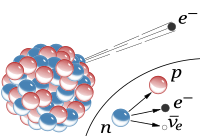
Photo from wikipedia
Disordered proteins often act as interaction hubs in cellular pathways, via the specific recognition of a distinguished set of partners. While disordered regions can adopt a well-defined conformation upon binding,… Click to show full abstract
Disordered proteins often act as interaction hubs in cellular pathways, via the specific recognition of a distinguished set of partners. While disordered regions can adopt a well-defined conformation upon binding, the coupled folding to binding model does not explain how interaction versatility is achieved. Here, I present a classification scheme for the binding modes of disordered protein regions, based on their conformational heterogeneity in the bound state. Binding modes are defined as (i) disorder-to-order transitions leading to a well-defined bound state, (ii) disordered binding leading to a disordered bound state and (iii) fuzzy binding when the degree of disorder in the bound state may vary with the partner or cellular conditions. Fuzzy binding includes polymorphic bound structures, conditional folding and dynamic binding. This classification scheme describes the structural continuum of complexes involving disordered regions as well as their context-dependent interaction behaviors.
Journal Title: International Journal of Molecular Sciences
Year Published: 2020
Link to full text (if available)
Share on Social Media: Sign Up to like & get
recommendations!